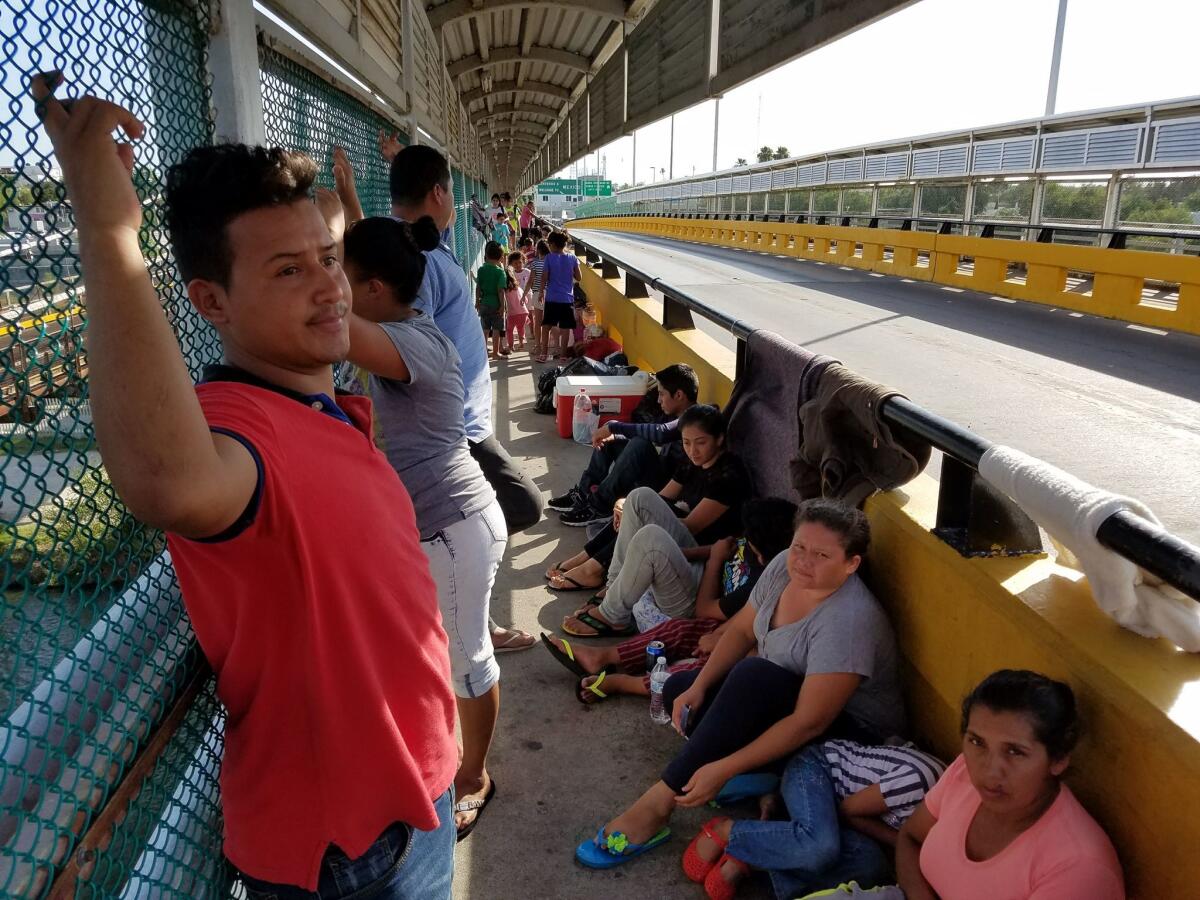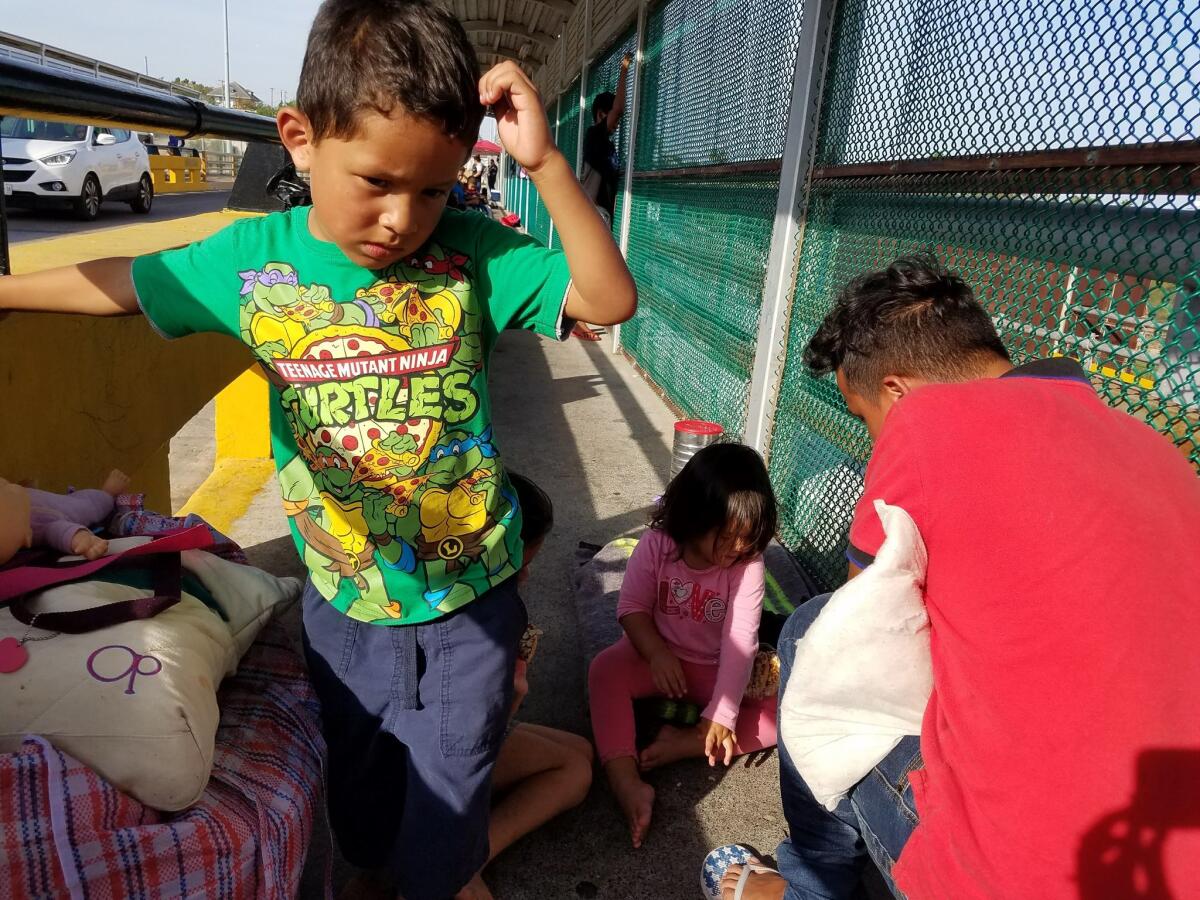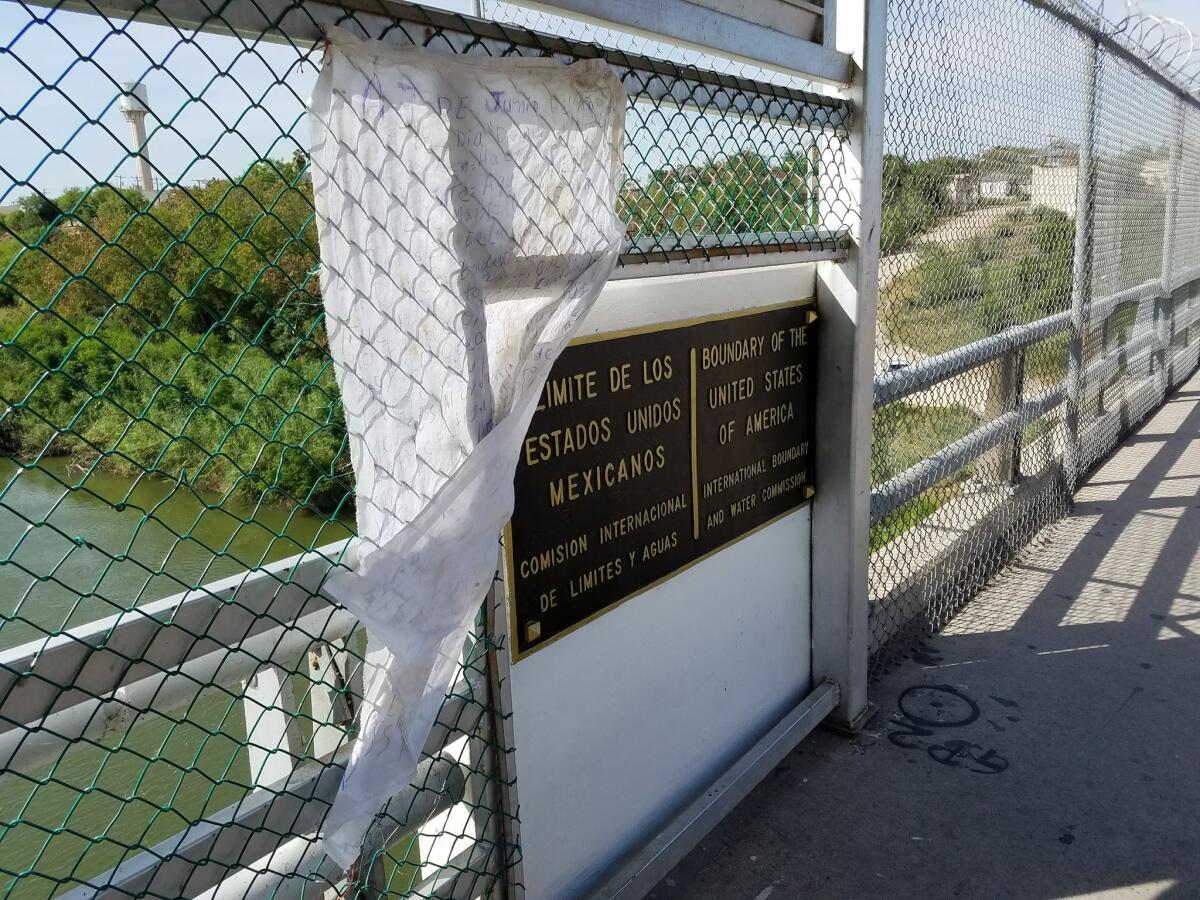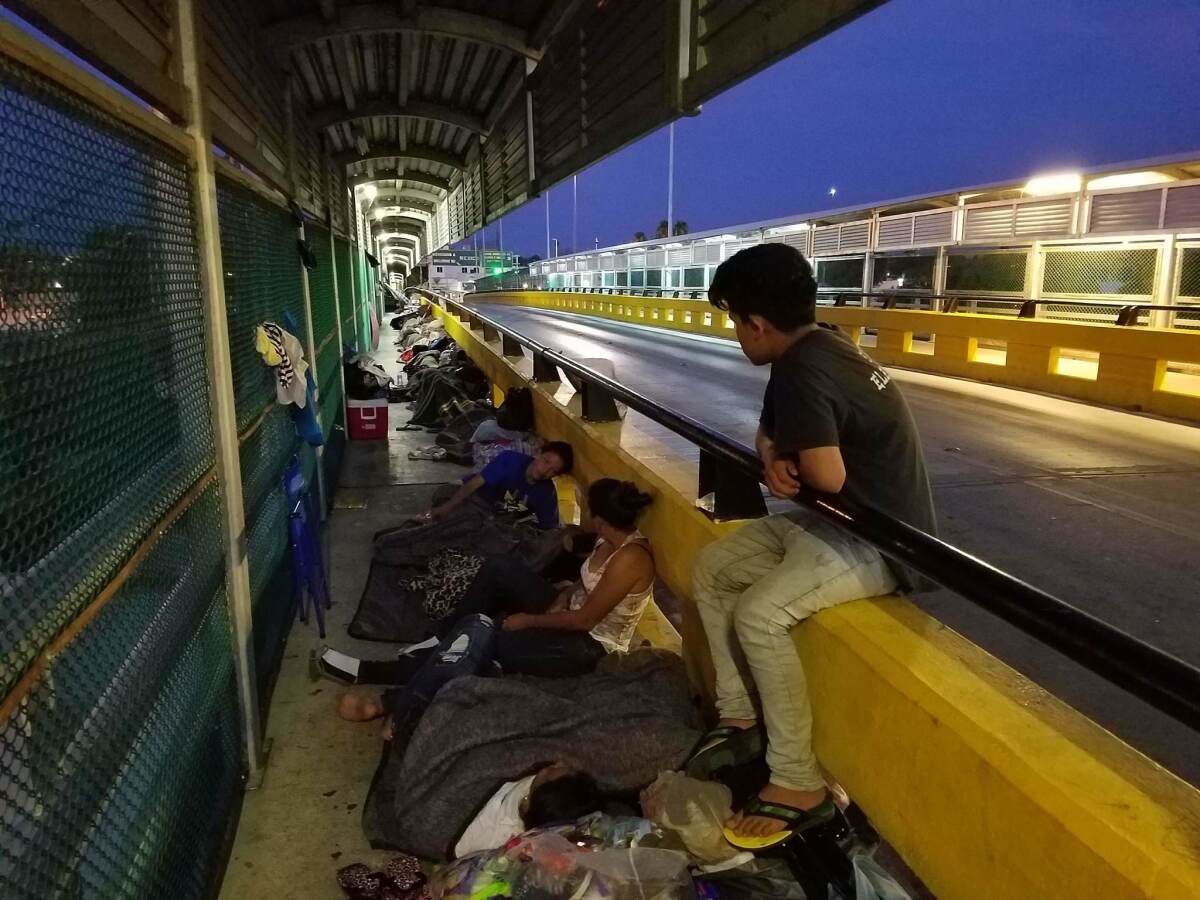Caught in limbo, Central American asylum-seekers are left waiting on a bridge over the Rio Grande

- Share via
Reporting from Ciudad Miguel Aleman, Mexico — A simple two-lane bridge spans the Rio Grande between Ciudad Miguel Aleman, Mexico, and Roma, Texas, sleepy sister cities that have long accommodated a steady flow of traffic back and forth across the border.
Regulars still cross daily, but lately they have encountered something new and disturbing.
Dozens of families from Guatemala, Honduras, El Salvador and Peru, some with babies only a few months old, have spent weeks living on the Mexican side of the bridge, waiting to be admitted to the United States as asylum seekers.
By Tuesday, nearly 50 people had camped on the bridge sidewalk coming from Mexico, half of them children. There was little shade, and in the afternoon, temperatures climbed above 100 degrees.
Bridge crossers weaved among sleeping babies, stepping over a Peppa Pig lunch box, a Moana coloring book, and dwindling stacks of bread and diapers. Fathers doled out powdered milk mixed with water in bottles to whining toddlers. Mothers strung underwear up on the cyclone fence sides of the bridge to dry in the strong wind blowing off the Rio Grande.

“Every morning we come, we wait in line,” said Marco Estrada, who was a grocery clerk in Honduras. He arrived with his 2-year-old daughter nine days ago, hoping to reach relatives in North Carolina. A gang had threatened him in Honduras, he said.
Maria Jose Alvarez extracted two Honduran birth certificates from the pocket of her jeans: her own and that of her 3-year-old daughter, Mitzy.
“We’re here in the street waiting, day and night,” said Alvarez, 20, before dawn Tuesday.
Those seeking asylum say they presented their documents to U.S. Customs officials on the bridge. But the officials said the families have to wait on the Mexican side because there isn’t enough space for them to be processed.
On Tuesday evening, Customs officials agreed to allow the first immigrants to cross into the U.S. from the bridge in nine days, those who had been waiting the longest: a Peruvian mother with two children and an unaccompanied 16-year-old from El Salvador, Estrada said. The next two families in line, both single mothers from Honduras traveling with children, were told they would be allowed into the U.S. late Tuesday or early Wednesday, Estrada said.
Requesting asylum in Mexico wasn’t an option, said those on the bridge: They would have more trouble finding work there, and they feared crime in Mexico as much as in their home countries in Central America.
The bridge delay arose as the Trump administration has moved to implement a new “zero tolerance” policy of charging those who cross the border illegally in federal criminal court, instead of processing them administratively in immigration court. Parents charged have been separated from their children, who have been placed at increasingly crowded federal shelters.
Many on the bridge said they paid $1,000 to get there because they thought that if they requested asylum they would be allowed to stay in the U.S. legally.
“We heard if you cross in the river they will separate you from your family,” said Estrada, 25, as he stood near the plaque marking the dividing line between the two countries. “That’s why we came on the bridge.”
Ruben Garcia, founder of the El Paso-based advocacy group Annunciation House, said the delays appear to be part of a strategy to block asylum seekers.
“They are using the pretext [that] we have to be judicious in recognition of our resources, our facilities are not set up to accommodate a lot of people, we can only receive them as we have space. They are using that tactic as a way to push people out and deny people asylum,” Garcia said.

The sudden influx is unusual for the bridge between Ciudad Miguel Aleman and Roma, which stands alongside an abandoned suspension bridge that previously served as the border crossing. The cities have a combined population of about 30,000 and see a brisk flow of legal crossers at dawn and dusk, mostly workers and families.
This week, some bridge regulars didn’t spare a glance at those clustered at their feet. Others donated clothing, food and water.
Immigrants who make asylum claims at a port of entry are supposed to be given a court date so a judge can determine if their asylum claim is credible. Under the Immigration and Nationality Act, anyone “who is physically present in the United States” has a right to apply for asylum. But they have to cross to the U.S. side of the bridge first.
Two uniformed U.S. Customs officials are stationed under a tent just on the U.S. side of the bridge’s dividing line, ensuring that none of the families pass. They referred questions to an agency spokesman.
The spokesman, Richard Pauza, in Laredo, Texas, said immigration officials’ ability to process applicants varies based on “the complexity of the cases, resources available, medical needs, translation requirements, holding/detention space, overall port volume and enforcement actions.”
Pauza said Customs officials at the various Rio Grande bridges are “taking a proactive approach to ensure that arriving travelers have valid entry documents in order to expedite the processing of lawful travel” and are processing people “as expeditiously as possible.”
During a visit to the border in South Texas on Monday, U.S. Customs and Border Protection Commissioner Kevin McAleenan emphasized that U.S. policy and procedure for receiving asylum seekers at the bridges has not changed.
“We are not denying people approaching the U.S. border without documents. We are asking them to come back when we have the capacity to manage them,” he said.
McAleenan said it was too early to gauge whether the Trump administration’s “zero tolerance” policy had deterred families from crossing, since it can take 25 to 30 days for those smuggled from Central America to reach the border. About 50,000 people were caught or turned themselves in at ports of entry at the border in May, he said, consistent with the previous two months.
[On Wednesday, two days after McAleenan spoke, Customs officials released new statistics showing that 51,902 people were caught or turned themselves in on the southern border in May. The figure for April was 50,968. The tally in March was 50,298.]

Huddling nearby under a blue blanket strung to the side of the bridge like a tent, Honduran Katy Trochez worried about her 3-month-old daughter. She was healthy and wriggling, but the nights had been cold. Other children were getting sick.
“I came for political asylum, but they don’t listen to us,” said Trochez, 19, repeating a common refrain among the bridge dwellers: They fled gangs, she said, including the notorious MS-13 and 18th Street, which had threatened to kill them and their children.
“Help us, understand us,” she pleaded in Spanish.
Pro bono lawyers have accompanied asylum seekers on other bridges, presenting their paperwork to officials and pressing their cases until they were allowed to apply for asylum and cross. Last year, the American Immigration Council filed a federal lawsuit in California challenging what it called the Trump administration’s efforts to block asylum seekers. The case is pending.
No lawyers were on the Ciudad Miguel Aleman bridge this week. As those on the bridge watched, others tried to cross the river below illegally in rafts. A few made it to the other side only to be rebuffed by Border Patrol agents on shore. Roma is one of the hottest spots on the border for illegal crossings, and the surrounding Rio Grande Valley leads the nation in the smuggling of both drugs and people.
Garcia, the El Paso-based advocate, said he worried the bridge delays could lead desperate people to try to cross the river illegally.
“It’s happening through all the border crossings,” he said. “You’ll see the same thing in El Paso, in Nogales, in Laredo, Calexico – it’s a border-wide policy.”
Garcia tried accompanying families to talk to U.S. customs officials on one of the El Paso bridges but was told they did not have room.
“You ask them ‘When can we come back?’ And they say ‘When we have room,’” Garcia said.
The Arizona-based Florence Project said it received reports of families seeking asylum stopped on bridges there this week and was sending lawyers to help them.
Mitra Ebadolahi, Border Litigation Project staff attorney at the ACLU of San Diego & Imperial Counties, said her organization became aware of people being stopped on the bridge to San Diego late last week and is monitoring the situation border-wide.
“These are people who are trying to follow the rules and present themselves as required,” she said.
The government’s response is “quite clearly unlawful,” said Denise Gilman, director of the University of Texas at Austin School of Law’s Immigration Clinic. “The lack of detention bed space does not take away the obligation under the law to process people seeking asylum. You shouldn’t need a lawyer. There is no fair access to the asylum process right now, which is a clear violation of U.S. and international law.”
Congressional lawmakers are starting to intervene. U.S. Rep. Beto O’Rourke (D-El Paso), who is challenging Republican Texas Sen. Ted Cruz, tweeted his office phone number and urged those stopped on local bridges to reach out so he can “make sure those seeking asylum are not being turned away or denied their right to request asylum.”
It’s not clear how long families stranded on the bridges can last.
After eight days on the bridge, single mother Wendy Yorlenis Orsoto Zambrano said her 5-year-old son was tired.
“He just says, ‘When are we going to move from here?’ I tell him, ‘Tomorrow,’” she said.
Estrada, a fellow Honduran, said he has not been eating, saving bread and other donated food for his daughter, Violet. He’s unwilling to return to Mexico and just as opposed to crossing into the U.S. illegally, which he knew would result in the pair being separated.
So they waited. When Violet ran down the bridge hand in hand with a new friend, he trailed behind. When she cried, he lifted her into his arms. Her mother was back in Honduras with a new boyfriend. For the past year, it had been the two of them, working toward entering the U.S. The weather forecast for the next week was bleak, all 100-degree days, the high Tuesday expected to reach 109. Still, they waited.
“I’m confident we will have the opportunity,” Estrada said. “I’ll wait as long as it takes.”
UPDATES:
9 a.m., June 7: This article was updated with new statistics on immigration enforcement at the U.S.-Mexico border.
4:50 p.m., June 5: The article was updated to report that some immigrants were allowed to cross into the U.S. to apply for asylum.
The article was originally published at 11:35 a.m. on June 5.
More to Read
Sign up for Essential California
The most important California stories and recommendations in your inbox every morning.
You may occasionally receive promotional content from the Los Angeles Times.











